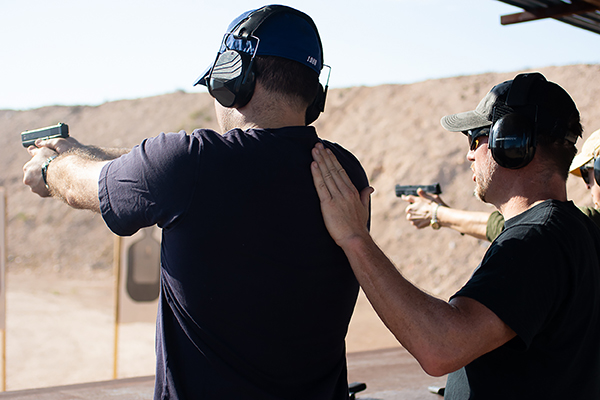The Case For Shorter Training Courses
Here’s a scenario that probably happens more than we realize: a prospective student researching training classes comes across wonderful courses being offered by amazing instructors. She’s taken several in the past and would like to take more. Then she sees they run for six to eight hours a day, for two, three or even five days. She knows they’re fantastic, empowering experiences but then she sees the cost. Between the time commitment and the price (and quite frankly, the stamina) required, she talks herself out of enrolling.
Finding Shorter Classes
To help alleviate this potential scenario, I started looking around to see if there were any alternatives to these very long, expensive classes.
The first thing I saw was USCCA classes being offered at my local gun club. And I noticed they are anywhere from one-hour modules to three hours, and the cost is affordable, about $25 per hour.
It’s a lot easier for a person to commit to $25 than $200. They can commit to one, two or three hours easier than eight hours or 10 hours for four or five days straight.
So, I spoke with USCCA Regional Training Manager Jennie Cruz to find out what led the organization to offer shorter training options.
Less Time Commitment
According to Cruz, USCCA started offering these classes in 2021 — in the anticipation of the industry trending toward shorter classes. She pointed out people generally don’t have time for eight-hour classes unless the class is mandatory.
“Our official partners saw the need for shorter classes, as well,” she shared. “It was right after Covid. People were still working at home and they weren’t going out as often; they didn’t want to be out in public as much. They would make it happen if they had to for a licensed carry class, but people just didn’t have that kind of time. USCCA was brilliant in taking the curriculum we have and turning it into what we call our mini-courses.”
The best part about these mini-courses is they don’t have to be taken in order, Cruz noted.
“It makes it so customizable to the student while still maintaining a comprehensive training experience,” she smiled.
When asked about student feedback, Cruz was ecstatic.
“Oh, the feedback has been phenomenal! Students really appreciate the fact they can come into a 55-minute to two-hour class. It’s usually not a problem at all for most people,” she said.
Next, in searching for other classes nearby, I found KR Training outside of Austin, Texas. While they do offer some longer classes, KR Training also has several classes about three hours in length. I contacted Karl Rehn, owner of KR Training, and he told me he figured out the issue of class length and cost several years ago.
He and John Daub wrote a book covering this particular topic, and just updated it for 2023 — Strategies and Standards for Defensive Handgun Training.
In Rehn’s chapter on strategies to get more people to take classes, he wrote, “Course length and cost can also affect the willingness of students to acquire training past required minimums.”
Rehn explained, “More than a decade ago, KR Training converted most of the courses it offers into three- and four-hour blocks designed as a series. Teaching everything someone needs to know in a four-hour class is an impossible task. Consequently, the burden is on the instructor to prioritize skills in their course design. The competition for course time is comprised of family and job responsibilities, other interests and, of course, dollars. The reality is more people can spend four hours, $100 and 200 rounds on a Saturday training class than there are people who can spend $500, 20 hours and 1,000 rounds on an all-weekend course.”
Information Retention
Cruz talks about the ability of students to retain information better in shorter classes.
“There is so much information to provide. You bring a new student into a class and they’re excited and anxious to get this information. But you throw them in an eight-hour class and they’re only going to retain a very small portion of what they learned because they’re overwhelmed,” she explained. “The need for a smaller bite of information is so important because it helps the student’s ability to absorb it. Then they come back for a follow-up class to build on what they’ve already learned, and it really improves student retention.”
Rehn added, “Those who study adult education understand deeper learning takes place if it is spread out in smaller chunks over a longer period. Students who come to a four-hour course pick up some new skills or corrections on old skills, spend the next month working on those specific things and then return for another four-hour block tend to progress better and maintain their improvement better than the student who spends his or her entire training budget for the year on a five-day class and then there’s no practice for months afterward.”
Rehn references an article by Craig Lambert, “Learning by Degrees” in Harvard Magazine’s Nov./Dec. 2009 issue. Lambert discusses what he calls “binge and purge” learning, a concept we’re all familiar with — cramming for a test to pass it, but then quickly forgetting the material.
“This mode of study doesn’t seem to produce durable learning,” Lambert assessed.
He then explains a concept called “spaced education.”
“More than 10 rigorous studies on medical students and residents using randomized trials have shown its efficacy: it can increase knowledge by up to 50%, and strengthen retention for up to two years,” he noted.
Bottom Line: What Do We Want FOR Firearms Students?
We complain most gun owners never get any training beyond the basics of whatever is required in their state. We blame it on a lack of priorities or thinking they know more than they do.
It’s not to say sometimes those reasons might not be true, but there are also many other factors like those mentioned above of cost, time and the ability to properly retain information and build on it.
So, what do we really want for firearms training? Do we want more gun owners to be able to afford the time to take classes? Do we want more gun owners to be able to afford the cost of training? Do we want long-term retention that will stay with students long after they leave the classroom?
Consider altering your approach to offering training courses here in the new year.






